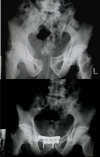Management outcomes in pubic diastasis: our experience with 19 patients
- PMID: 21586135
- PMCID: PMC3108341
- DOI: 10.1186/1749-799X-6-21
Management outcomes in pubic diastasis: our experience with 19 patients
Abstract
Background: Pubic diastasis, a result of high energy antero-posterior compression (APC) injury, has been managed based on the Young and Burguess classification system. The mode of fixation in APC II injury has, however, been a subject of controversy and some authors have proposed a need to address the issue of partial breach of the posterior pelvic ring elements in these injuries.
Methods: The study included a total of 19 patients with pubic diastasis managed by us from May 2006 to December 2007. There was a single patient with type I APC injury who treated conservatively. Type II APC injuries (13 patients) were treated surgically with symphyseal plating using single anterior/superior plates or double perpendicularly placed plates. Type III injuries (5 patients) in addition underwent posterior fixation using plates or percutaneous sacro-iliac screws. The outcome was assessed clinically (Majeed score) and radiologically.
Results: The mean follow-up was for 2.9 years (6 months to 4.5 years). Among the 13 patients with APC II injuries, the clinical scores were excellent in one (7.6%), good in 6 (46.15%), fair in 4 (30.76%) and poor in 2 (15.38%). Radiological scores were excellent in 2 (15.38%), good in 8 (61.53%), fair in 2 (15.38%) and poor in one patient (7.6%). Among the 5 patients with APC III injuries, there were 2 patients each with good (50%) and fair (50%) clinical scores while one patient was lost on long term follow up. The radiological outcomes were also similar in these. Complications included implant failure in 3 patients, postoperative infection in 2 patients, deep venous thrombosis in one patient and bladder herniation in one of the patients with implant failure.
Conclusions: There is no observed dissimilarity in outcomes between isolated anterior and combined symphyseal (perpendicular) plating techniques in APC II injuries. Single anterior symphyseal plating along with posterior stabilisation provides a stable fixation in type III APC injuries. Limited dissection ensuring adequate intactness of rectus sheath is important to avoid long term post-operative complications.
Figures






References
MeSH terms
LinkOut - more resources
Full Text Sources

